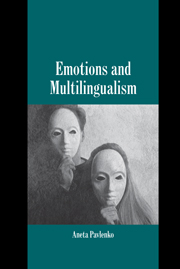Book contents
- Frontmatter
- Contents
- List of Tables
- Preface
- 1 Languages and emotions: What can a multilingual perspective contribute?
- 2 Emotions in the study of multilingualism: Framing the questions
- 3 Vocal level: Is the lady angry?
- 4 Semantic and conceptual levels: The bilingual mental lexicon
- 5 Discursive level: I feel zhalko tebia bednogo
- 6 Neurophysiological level: His coeur is where his feelings dwell
- 7 Social cognition: I no longer wanted to speak German
- 8 Emotions and multilingualism: An integrated perspective
- Appendix A Bilingualism and emotions webquestionnaire
- Appendix B Transcription conventions
- References
- Author Index
- Subject Index
8 - Emotions and multilingualism: An integrated perspective
Published online by Cambridge University Press: 11 November 2009
- Frontmatter
- Contents
- List of Tables
- Preface
- 1 Languages and emotions: What can a multilingual perspective contribute?
- 2 Emotions in the study of multilingualism: Framing the questions
- 3 Vocal level: Is the lady angry?
- 4 Semantic and conceptual levels: The bilingual mental lexicon
- 5 Discursive level: I feel zhalko tebia bednogo
- 6 Neurophysiological level: His coeur is where his feelings dwell
- 7 Social cognition: I no longer wanted to speak German
- 8 Emotions and multilingualism: An integrated perspective
- Appendix A Bilingualism and emotions webquestionnaire
- Appendix B Transcription conventions
- References
- Author Index
- Subject Index
Summary
My mother says I'm becoming “English.” This hurts me, because I know she means I'm becoming cold. I'm no colder than I've ever been, but I'm learning to be less demonstrative.
(Hoffman, 1989: 146)The closing chapter of a scholarly book commonly aims to end and summarize the story told in the preceding chapters. This book is no different in that I will indeed try to close and summarize. It is different, however, in that there was no single story told on its pages. Rather, for those who never thought of emotions and multilingualism in a single sentence, I pointed to a number of important connections between the two phenomena. For those who thought there was only one lens through which the relationship could be considered, I highlighted the existence of several lenses and, with them, several stories that could be told. For those who thought there was one dominant story – that of L1 being the language of emotions – I told an alternative story, that of affective socialization into an L2. The possibility of affective (re)socialization in a new discursive community, which the opening quote vividly illustrates, is perhaps the most prominent new story to emerge from this book.
In addition to telling new stories, academic books also challenge earlier stories and accounts. In keeping with this tradition, I have tried to dismantle the myth of a simple, tangible, easily described relationship between the languages and emotions of bi- and multilingual speakers, and to show that this relationship plays out differently for different individuals, and even in the distinct language areas of a single speaker.
- Type
- Chapter
- Information
- Emotions and Multilingualism , pp. 227 - 246Publisher: Cambridge University PressPrint publication year: 2006



